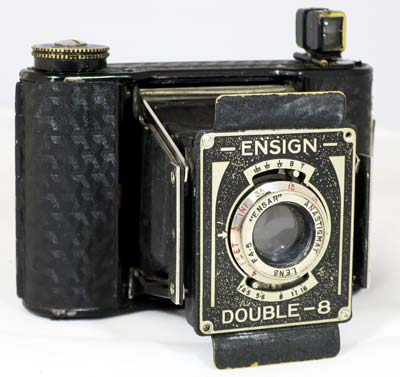Ensign Double-8
Specification

| Manufacturer | : | Houghton-Butcher Manufacturing Co Ltd |
|---|---|---|
| Produced | : | 1935 |
| Classification | : | Miniature |
| Body Type | : | Folding Strut |
| Construction | : | Metal |
| Film Type | : | 127 |
| Film Width | : | 46mm |
| Image Size | : | 1¼ x 1⅝ |
| No. of Images | : | 16 |
| Lens Type | : | Ensar-Anastigmat |
| Focus Type | : | variable |
| Focal Length | : | 50mm |
| Focal Range | : | 3ft - inf. |
| Aperture Type | : | Iris |
| Apertures | : | f/4.5 - f/16 |
| Shutter Type | : | Variable |
| Shutter Speeds | : | T, B, I(1/25, 1/50, 1/100) |
| Size Open (w x h x d) | : | 95 x 75 x 65 mm |
| Size Closed (w x h x d) | : | 95 x 68 x 24 mm |
| Weight | : | 255g |
Art Deco Credentials
![]()
![]()
![]()
Noteworthy: Worth giving special attention
- Produced during the main Art Deco period.
- Geometric design on front face.
- Chrome used on struts.
- Repetative geometric pattern on body covering;
- Chrome used on tripod bush.
Description
The Ensign Double-8 camera is a strut folding camera for 3 x 4 cm pictures on 127 rollfilm. It takes 16 exposures on standard 8 exposure film. It is a metal body camera with cloth covering and leather bellows. The covering has the same pattern as was used on the Ensign Mickey Mouse camera of the same era.
The shutter is a pivoted two-blade return type which is spring powered, giving speeds 1/25, 1/50, 1/100, B, T. The shutter release is above the lens behind the front plate. Apertures available are f/4.5 to f/16. Focussing is achieved by turning the front lens and it can focus down to 3 feet.
It has a direct vision lens powered view-finder which folds down for storage. Film advance is by two red windows. Film advance is not coupled to the shutter. On the rear is a depth-of-field table. A tripod bush is provided.
How to Use
View the Ensign Double-8 User Manual.
This camera takes 127 film which is still available from select outlets - search for 'Rera Pan 100-127' which is a black & white film. For those photographers in the UK, try Nick & Trick photographic services. If you want to use a particular type of film which is not available commercially, then you can cut your own 127 film from any 120 film. See my page on 'How to cut 127 film from 120 film'. Don't forget to cover the red windows except when advancing the film in low light. Modern film is sensitive to red light.
The two red windows are used to get 16 exposures from 127 film. The film is advanced until a number appears in the first window and an image is taken. Then the film is advanced until the same number appears in the second window. Then it's back to the first window for the next number. Don't forget to cover the windows with black tape except when advancing the film in low light.
Don't forget to raise the viewfinder to the portrait position. Folded down is just for storage.
If you don't want to bother with an exposure meter, follow the guide shown, using shutter speeds are 1/25s, 1/50s and 1/100s only. It is based on the 'Sunny 16' rule. Film is so forgiving and will produce acceptable results even when overexposed by 2 or 3 stops or underexposed by 1 stop.
Remember that the exposure guide in the camera user manual may not be helpful as it is based on the use of old film with a low ISO value.
The tables assume that the sun is at least 30 degrees above the horizon - that's 10am - 5pm on a summer's day (May-August) in the UK.
If you are not sure about the light level, err on the side of overexposure - i.e. assume the smaller f number.
Where there is a choice, a larger f number will give a larger depth of field.
For the slower speeds, you may need a tripod to stop blur through shake.
Using ISO 100/125 film
| Weather Conditions | Shadow Detail | Shutter Speed (s) | ||
|---|---|---|---|---|
| 1/25 | 1/50 | 1/100 | ||
 Sunny SunnySnow/Sand | Dark with sharp edges | - | - | - |
 Sunny Sunny | Distinct | - | - | f/16 |
 Slight Overcast Slight Overcast | Soft around edges | - | f/16 | f/11 |
 Overcast Overcast | Barely visible | f/16 | f/11 | f/8 |
 Heavy Overcast Heavy Overcast | None | f/11 | f/8 | f/5.6 |
 Open Shade Open Shade/Sunset | None | f/8 | f/5.6 | f/4.5 |